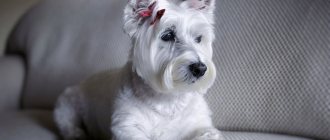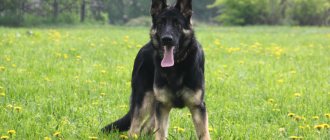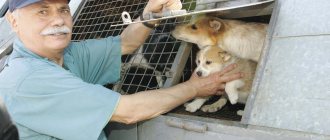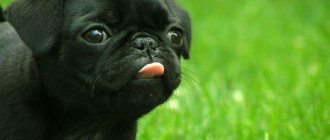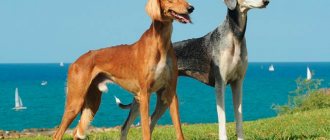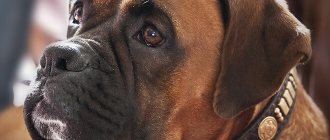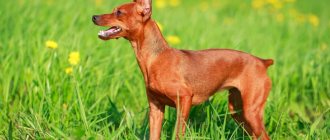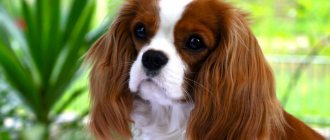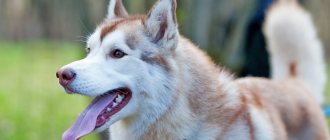The Dogo Canario, or "Perro de Presso Canario" is a massive, well-fed dog, resembling a pile of muscles with a proud, intelligent look. The breed was bred artificially. In history, dogs are listed as shepherds and fighters.
Outwardly ferocious animals cause fear in people, but their owners call them docile, kind four-legged friends. They even get along with cats. Despite positive reviews, in some countries, the Spanish dog is banned. Before you get a puppy of this scary breed, you need to familiarize yourself with all the nuances.
Breed standard and description
Height at withers: males 60-66 cm, females 56-62 cm. Weight: males 50-65 kg, females 40-55 kg.
- Color: brindle of all shades, fawn (sand), a dark mask on the face is required, white markings on the limbs and body are acceptable.
- Eye color: dark or medium brown.
- Nose color: black.
- General appearance: short-haired dog with powerful limbs, moderately pronounced muscles. Proportional and strong build. Balanced and attentive, moves freely.
Personality: attitude towards children and animals
Despite the fact that the dimensions of the Canario dog are quite large, the dog has a calm and balanced character. He does not show aggression towards people.
However, despite all this, you should not leave your dog alone with a little boy or girl. The Great Dane is not suitable for the role of a nanny and therefore children should play with it only under adult supervision.
Representatives of the breed also get along well with other animals. If socialized from an early age, they can be kept under the same roof with other pets.
History of the breed
The breed originated in Spain, on the Canary Archipelago. The closest relatives are the dogs of the natives, who were nicknamed majorero . They lived on the islands even before the arrival of the Spanish conquerors. The Great Dane appeared due to the crossing of a native dog with mastiffs imported from outside.
Other names for Dogo Canario:
- Dogo Canario (adopted into the RKF).
- Perro de Presa Canario (historical name, translation - “grasping dog”).
- Presso de Canarrio.
- Canary Mastiff.
- Canary dog.
When the breed was formed, they began to be used to guard livestock . Dogo Canarios coped with the assigned tasks with ease. They were considered real workers, assistants to residents, as evidenced by entries in special city books.
These large and fearless dogs with dark brindles on their fur stood up to predators and strangers. The dimensions of the Dogo Canario made it possible to drive large herds of bulls . They often served as a guard dog at home . Moderate anger towards strangers was combined with a willingness to obey even the smallest members of the owner's family. Dogo Canarios were valued by their farmer owners for their independence, strength and balance.
The peak of the Dogo Canario's popularity occurred in the 16th-17th centuries, but it turned out extremely tragically for the breed. In parallel with these dogs, the islanders also bred Perro de Gonado , whose individuals were distinguished by their cool disposition and large size. There were frequent matings between these two breeds. The result was official restrictions on the use of both species by the authorities, and then a ban on their keeping . The sanctions for the Canary Danes were softer, and the population was barely saved.
Later they were crossed with dogs of the Spaniards, English and French. Dogo Canarios were now involved in fighting . Since then, the breed has practically disappeared, individuals differed sharply from each other in size, new colors appeared, and the psyche of mestizos was not stable. They selected baiting dogs with increased aggression, strong grip, and heavy weight.
By the middle of the 20th century, Canarians were becoming less and less common in ordinary households. They had to be kept on a chain, and only butchers or farmers could become owners. Great Danes no longer roamed the streets in free flight.
Many breeds would disappear without a trace without people who are passionate about dogs. This happened with Dogo Canario. They have been bred anew for decades, collecting purebred individuals from the corners of the islands, sometimes resorting to reasonable crossbreeding. By the 1980s, the world saw the pride of Spanish cynology - the Dogo Canarios in its true form. Initially, the restored breed was recognized by the country's club, then the standards were approved by international organizations.
Today Dogo Canarios participate in major exhibitions, including certification ones. The population is constantly growing, Dogo Canarios receive prestigious titles, and puppies of high-breed parents travel to different countries. Unfortunately, in some countries the import of these dogs is prohibited due to cases of unmotivated aggression.
Health
Take your pet to the veterinarian for regular checkups. Such visits will help keep the Dogo Canario’s health under control and begin timely treatment of detected diseases.
Representatives of the breed are not predisposed to serious hereditary diseases; they have strong immune defenses. But, like any living creature, pero de presa often has the following health problems:
- Epilepsy is a disease that cannot be cured, but it can be controlled by reducing the number of seizures accompanied by convulsions.
- Joint dysplasia is characterized by severe pain, sometimes unbearable. Without timely treatment, the dog may lose the ability to move.
- Entropion, eversion of the eyelid cannot be treated and requires surgical intervention.
- Scabies is a skin disease caused by mites.
- Diseases of the gastrointestinal tract - volvulus, bloating, diarrhea.
It is mandatory to get vaccinated on time. Deworming and treatment for skin parasites is also important.
Temperament and character
The Dogo Canario is a working dog, but the standard does not require specific tests to check qualities and mental testing.
Positive traits:
- Self-confidence;
- Equilibrium;
- Endurance;
- Ability to stand up for yourself and the owner;
- Independent decision making;
- High level of intelligence;
- Unpretentiousness.
The following may seem negative:
- Distrust of strangers;
- Dominance;
- Stubbornness.
Pros and cons of the breed
The Dog Canario has many advantages, but there are also negative traits. It is important to familiarize yourself with them in advance.
| pros | Minuses |
| Devotion, complete obedience to the owner | The breed is only suitable for experienced dog lovers |
| Easy to learn | Dogs have an independent character |
| Positive attitude towards children | Requires constant training |
| No outbursts of aggression | In the absence of education, it poses a danger to others and the owner |
| Quick response in case of danger | |
| Easy to care for | |
| Ability to live in apartment conditions |
Dogo Canario and man
The Dogo Canario loves to work , so it can become a good bodyguard, watchman and devoted companion. Despite his molossoid appearance, he moves easily: he is much smaller than the same modern St. Bernard or Caucasian Shepherd Dog. These facts indicate the ability to withstand prolonged loads, mobility, and dexterity.
It is best for such a dog if it goes to an experienced and strict owner . Protective qualities are evident from an early age, and the history of the breed and its original purpose indicate possible difficulties in education. However, aggressive behavior in Great Danes is considered a defect, as is an unstable psyche. Moderate viciousness is a quality that distinguishes a dog that is capable of repelling an enemy, but in exceptional cases.
Because of this, beginners, people with a soft character, and older people with problematic health are not recommended to have such a serious dog as a Dogo Canario.
They begin to guard from a few months from birth, but the lack of undercoat and short hair will not allow them to survive outside in the cold. They live either in a house/apartment or in a separate heated room. Dogo Canarios are not annoying, take up little space, and do not require constant attention. They shed , and short hair can cause allergic reactions in people.
With proper handling and upbringing of your pet, there should be no problems in interacting with children. Other smaller pets are usually perceived as objects of protection.
Training and physical activity
The Dogo Canario needs competent early socialization and training. Despite all the positive character traits, training a Canarian and instilling in him the skills of a defender is a long process and not always easy. For a dog there is only one owner, who must first earn the respect and recognition of the puppy. Only leadership qualities, perseverance and rigor will be the main assistants in education. Dogo Canarios have their own opinion on the necessity and speed of executing commands. Not wanting to train, they will pretend and cheat. The Dogo Canario skillfully imitates deafness, fatigue or stupidity. Excessive softness, as well as spoiled behavior, can lead to destructive behavior, disobedience and related problems.
In the process of training, it is important to stop the dog’s inadequate reaction to external stimuli: cats, small dogs, other people’s children.
A strong dog with a death grip can indeed be balanced and obedient, but again, only if properly trained. It is worth preparing for the fact that the Great Dane will periodically “test” the owner for “professional suitability”, checking whether he has lost his leadership qualities and whether he can remain a leader.
The Dogo Canario is a strong, resilient dog that can walk around the territory all day and make sure that wild animals or strangers do not covet the herd. If the Canarian does not have a permanent job, he needs long walks and good physical activity. Can engage in various sports.
Maintenance and care
During the warm season, the Dogo Canario enjoys being outside all day. To protect him from precipitation, he is provided with free access to the booth and enclosure. Dogs of this type can be kept on a chain if its length is at least 5-7 meters , and the pet can move freely in the block, but daily long walks in such a situation are required. Most Dogo Canarios still live in their owner's house.
They are adapted to heat, but you should not abuse their exposure. In winter, when walking, they can withstand significant frosts; clothes for them are rarely purchased. At the same time, the dog must move so as not to freeze. In severe winters, the pet is dressed in a suitable blanket or overalls.
Walk the dog twice a day . In your free time, you can increase the number and duration of walks, but make sure that the animal can rest.
Loads on puppies and juniors are measured, otherwise joints and ligaments may be damaged.
Approximate diet:
- Beef, chicken, turkey meat;
- Offal, large beef bones;
- Cereals;
- Eggs;
- Cottage cheese, kefir, whey;
- Vegetables fruits;
- Sea fish.
A dog of this size can be raised without supplements, but to be on the safe side, owners get tested at a veterinary clinic and, together with specialists, determine the need for minerals and vitamins. It is advisable to cook jellied meat, do not neglect fermented milk products, some vegetables and fish, so that the musculoskeletal system of the growing Dogo Canary is properly formed.
Caring for the coat of this breed is easy. However, during molting, the prickly hairs cause discomfort to owners. To prevent unpleasant moments, you can wash your pet with regular dog shampoo, without conditioner and balm, dry it thoroughly with a compressor (powerful hair dryer) and comb it with a short and frequent-toothed brush. Excess hair will come off under the influence of air currents and will not be scattered throughout the apartment.
For a working dog, teeth are the main tool. Turkey necks, cartilage, large sinews and sugar bones are served for a gentle cleansing of plaque. If there is a large amount of tartar, you should contact a veterinarian.
Cropped ears should stand up after the change of baby teeth, before one year from birth. If there are some problems, then they revise the diet or add glue. Clean when dirty. The claws are shortened with forceps (claw clippers).
Character
The Dogo Canario has a calm, balanced temperament, but at the same time he is unusually active in his work, which indicates impulsive behavior. Loyal to his owner, obedient and self-confident. First of all, it is adapted for protective guard duty. The Dogo Canario has a stable nervous system. The dog is calm, perhaps even a little phlegmatic, but only as long as it does not concern work or play. Then he can surprise with his activity and dexterity. Often does not like other people's dogs and can provoke fights.
It is worth considering that the Dogo Canary is stubborn and very capricious, sometimes striving for independence and dominance. With good upbringing and genetics, he prefers to be close to his owner, and understands that his job is to protect the family and their property. He behaves friendly with his family.
The demeanor represents strength and confidence. The Canary is very vigilant and suspicious of strangers. At the slightest alarm signal, he takes a defensive pose and evaluates his surroundings with a wary gaze. Any attempt by a stranger to inspire trust or negotiate with the formidable guard will irritate the latter. The silent, observant and curious Dogo Canary clearly defines his territory and family; it is not easy to get into the list of his trusted persons.
The Dogo Canario has recently become known as a killer dog due to several attacks. Two incidents received wide publicity in the United States. In 2001, a 33-year-old San Francisco resident died as a result of an attack by two dogs. In 2006, in Florida, a dog of this breed caused life-threatening injuries to its owner. In this regard, the breeding and sale of Dogo Canario is prohibited in some countries, in particular Australia and New Zealand.
Education and training
Dogo Canarios, given their size and historical purpose, are well trained . They differ in temperament and way of thinking from many human-oriented breeds (Malinois, German Shepherds, Dobermans), so you cannot demand from them unquestioning execution of commands after the first repetition. Patience and work during adolescence will ensure mutual understanding between the owner and the pet in the future.
During puberty, a dog can test the owner’s strength, this is usually visible in small things and is quickly stopped by an attentive person.
With Dogo Canarios, it is recommended to take a general training course , and if you want to raise a reliable guard, a guard duty course . In sports (freestyle, agility), Dogo Canarios rarely become winners due to their size and temperament, but they can be found among participants in the large category (for dogs with a height at the withers of over 43 cm). Active dog owners sometimes get involved in freestyle, not expecting victories in competitions, but enjoying working with their pet and the acquired skills.
Health and illness
Pets often have joint problems. The main disease of the breed is dysplasia, abnormal tissue development. Pathology affects Canarians in the area of the hip joints. Due to their massive size, they are prone to volvulus. Sudden movements and overeating of the animal should be avoided.
It is impossible to fight dysplasia through prevention. The disease is hereditary. Dogs with this diagnosis are not allowed to be sold or bred. The eyes are affected by multifocal retinopathy - an inflammatory process of the mucous membranes. The pathology is also called “sclera”.
With proper care and regular visits to the veterinarian, diseases rarely develop. The dog is treated against ticks with aerosols and special collars. Periodically it is worth giving your dog medications against helminthic infestations.
To prevent infectious and viral diseases, you should vaccinate your Great Dane. Vaccinations are carried out according to the schedule established by the veterinarian.
Breed photo
A selection of photos of Dogo Canario.
Choosing a puppy
Choosing a Dogo Canario puppy is a responsible task, since the baby must come from healthy and mentally balanced parents. To do this, it is important to contact official breeders who will be able to provide all the information about the animal and its ancestors, and also confirm the pedigree of the breed. It is difficult to confuse a Canary dog puppy with a purebred one - it will be large, with a coat color acceptable according to the standard, moderately large eyes and correct proportions. It is worth understanding that the breed is not the most common, so buying a baby can be difficult. The cost is also high - from 800 to 3000 dollars.
Caring for a Dogo Canario
When caring for a representative of the breed, you need to follow several important recommendations:
- Balanced diet. Large dogs expend a lot of energy, and the need for movement, coupled with heavy weight, puts significant stress on the joints, which is why it is important that all the minerals and vitamins the animal needs are supplied with food. A natural diet should be formulated by a professional, taking into account the parameters and activity level of a particular dog. There are no specific prohibited foods for the breed; general recommendations and restrictions apply: more than 60% lean meat in the diet, vegetables, unsweetened fruits, greens, fermented milk products and cereals, nothing salty, smoked, spicy, fried or fatty. When purchasing dry food, the main emphasis should be on its quality; it is important to choose proven super-premium and holistic products for large breeds (for example, Royal Canin Maxi Joint Care for large dogs with hypersensitivity of the joints, Grandorf Lamb & Rice Adult Maxi 26+, Brit Premium Adult XL for dogs from 45 kg, etc.)
It is important not to overfeed your pet, otherwise a large dog will develop additional health problems due to obesity.
Dogo Canarios require food formulated specifically for large breeds
- Brushing and bathing. Short hair is easy to care for; it needs to be brushed at least once a week to remove loose hairs. Bathing with shampoo is done as needed (2-3 times a year), but if the dog loves water, then you can give it chemical-free treatments if desired.
- Constant training. The Presa Canario is a large dog prone to dominance, which raises the issue of proper training. It is definitely not suitable for a novice dog breeder; an experienced owner is needed. It is better to go to a professional for a training course, but in ordinary life you should not give in to slack - the rules must be strictly followed without exceptions. You cannot show physical force to an animal, this causes aggression. Socialization from puppyhood is of great importance.
Cane Corso: characteristics of the breed
One of the most ancient breeds is the Molosser, a fighting dog that was used for baiting during wild boar hunting. In the Middle Ages, Italian dogs became widespread in Europe as guard dogs. His powerful torso and terrifying appearance attracted the attention of artists. The dog has become the personification of fearlessness and courage.
After the 40s of the last century, the dogs practically disappeared, but the Italian Giovanni Nizolli revived the ancient breed. Now this is a popular breed among dog lovers.
Features of the Cane Corso. They were created to protect and protect people and livestock. They are distinguished by strength and endurance, and have high intelligence. The innate reflex of protection allows them to show restraint and restraint. They attack only in extreme cases after the order of the owner. Not prone to unbridled rage and outbursts of aggressive behavior. This is an excellent protector who protects not only the owner and the territory, but also the entire family.
Photo from Instagram account supersic589
Photo from Instagram account supersic589
Exterior. The breed is characterized by strength and power. Muscular body with strong legs, elegant build. The head is large with a wide skull, a convex forehead and a pronounced furrow on the forehead. The coat is short with a weak undercoat and a variety of colors from black to light red. A black or gray mask is found only in brindle and red dogs.
The nose is wide, straight with pronounced nostrils for good breathing. The muzzle is not longer than the skull and is massive. The upper lips droop, completely covering the lower jaw. Powerful, curved jaws with strong teeth create a dense bite. The eyes are medium-sized, oval, slightly convex, and straight set. The shade of the eyes most often depends on the color. The ears are triangle-shaped, drooping, and often cropped.
Body with a straight back, short muscular neck. The tail is docked to the 4th vertebrae. The chest and shoulders are powerful and have strong muscles. The legs are slender, the paws are large and compact. The skin fits tightly and is very thick.
Main problems: hip dysplasia, which cannot be treated. Occurs in an average of 30% and can appear immediately or at the age of 5 years. Up to 2 years of age, increased loads should not be given until the bones become stronger. Dogs are also susceptible to allergies and eyelid diseases.
Nutrition. Feed 2 times a day, there must be fresh water in an accessible place. Dogs eat a lot; their diet must be balanced. The best dry food is premium series or holistic for large dogs. When eating natural foods, give meat other than pork. River fish, sour cream, tubular bones, sweets, and cereal porridges are not allowed. Be sure to add vitamin and mineral complexes.
Hygienic measures. Short hair does not require care; you only need to bathe it once every six months. You need to clean your ears and wipe your eyes with chamomile infusion. After a walk, wash your paws, removing dirt and reagents, and lubricate your paw pads with vegetable oil or special wax.
Walking twice a day in the fresh air is required. Dogs are heat-loving dogs, so they should not live outside in winter.
Origin of the breed
The Dogo Canario has several names, the most popular being Dogo Canario, Presa Canario, and Perro de Presa Kanario. The history of the breed is reflected in its name. The name of the breed reveals its origin better than any words. The Canary Islands are considered to be the homeland of the Dogo Spaniard. Initially, the dog was bred as a fighting dog, as evidenced by its physique, characterized by power and strength, as well as its Spanish name (Perro de Presa Kanario - the word Presa is translated as capture). In the mid-20th century, dog fighting was banned; the Canarians found use for the breed as a guard dog. They protected herds and lands.
Nowadays, it is almost impossible to meet a purebred Dogo Canario. To soften its initial ferocious traits and qualities, these animals began to be crossed with other breeds.
Character, habits and training
Well-trained, with regular exercise and without congenital psychological abnormalities, the Dogo Canario is a serious, loyal and slightly phlegmatic dog. The Dogo Canario's character does not allow for excessive aggression, but all the positive qualities may not manifest themselves if you neglected training courses with a professional dog handler. The breed is completely unsuitable for people without experience in raising large guard breeds.
Training requires endurance, rigor and perseverance from the owner. The breed is naturally very intelligent, but like all dogs, the Dogo Canario's intelligence is always accompanied by cunning. The puppy may begin to pretend to be very tired, dull and confused, so if you do not show persistence, then after a couple of indulgences the training process will be left to chance.
In everyday life, the dog, in addition to active and long walking, requires respectful treatment. If a dog lives in an enclosure, then it should be insulated, or better yet, heated, and during the day the dog should move around the area and not sit locked up. Sitting on a chain, the breed runs wild and becomes more aggressive.
The Dogo Canario dog breed treats household members quite warmly, highlighting only the owner as special favorites. Tolerant of children, but contact with children under 10 years of age is not advisable. But relationships with other animals may not work out. If you had other dogs and cats, and then a Great Dane appeared, then there is still a chance for coexistence, but bringing a new pet into a Great Dane’s house is a big risk.
If you are a responsible owner, have completed a general training course with your dog and a security course in a special school, then you will see in your pet a sensitive but fierce guard who will calmly walk with you down the street, but at the first signals of danger he will growl, and then will rush. That is why the breed, even under conditions of serious upbringing, must be walked on a strong leash and muzzle.
IMPORTANT: Socialization will help your pet walk safely every day. Take the puppy to crowded places, invite guests, let the dog get used to the fact that not all people are a danger to the owner, let the dog get used to being more patient with strangers from a young age.
Training
Canario is a breed that can cause a number of difficulties for owners. The Great Dane is not a decorative dog, this is its peculiarity. His strong point is self-will. Raising a dog correctly is a complex and time-consuming process. For Canarians, there is only one owner, and he is directly responsible for raising and training his pet. If someone else from the family tries to get involved in this matter, then it will bring nothing but harm. You need to be persistent and demanding to achieve authority.
Dog training should begin as soon as it crosses the threshold of the house. The puppy will definitely start gnawing on everything - he will have to be weaned from this. Young Canarians do not always consider it necessary to respond to the owner’s commands, much less carry them out. They begin to be cunning, demonstrating their fatigue, and pretend to be indifferent. During this period, it is important to behave correctly. You cannot give in, as this will only complicate the establishment of leadership.
Purpose of the breed
Initially, presa canarios served as assistant shepherds to guard the flock. Then the aggression and thirst for prey of such dogs was used by butchers when slaughtering livestock. At one time, these dogs were often used to exterminate stray dogs that bothered the inhabitants of the Canary Islands.
To this day, Canary Dogs actively take part in various competitions, as well as in dog fights.
They can also be observed in the service of law enforcement agencies, where they show their best qualities: excellent sense of smell and hearing, endurance and endurance, and the ability to make independent decisions. Mostly, such pets are bred to guard and protect families and territories, and also as companion dogs.
